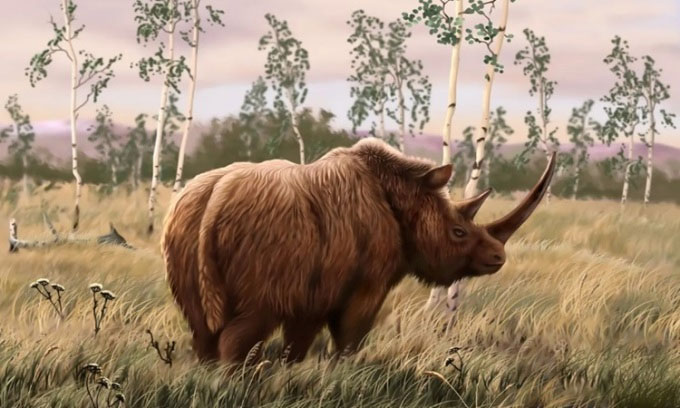32,400-year-old rhino mummy found with intact skin and fur
A woolly rhinoceros mummified for tens of thousands of years in permafrost provides valuable insights into the extinct species.
A complete woolly rhinoceros was discovered near the Tirekhtyakh River in Russia's Sakha Republic . The frozen mummy dates back 32,400 years. Scientists led by Gennady Boeskorov of the Institute of Geology of Precious Metals and Diamonds of the Russian Academy of Sciences analyzed the rhinoceros. The creature, called the Abyisky rhinoceros , provided the research team with unique insights into the past. Although the animal is more than 32,000 years old, many of its soft tissues, skin, and hair were still intact in the subzero permafrost. This state of perfect preservation allowed researchers to study the anatomy of the ancient rhinoceros in unprecedented detail, Interesting Engineering reported on September 23.

Reconstruction of the ancient woolly rhinoceros. (Photo: Ozja).
The woolly rhinoceros was a large, hairy, two-horned animal that lived in Eurasia during the Pleistocene. Its scientific name is Coelodonta antiquitatis. The woolly rhinoceros lived at the same time as the woolly mammoth during the Ice Age. It was the second largest animal in its ecosystem, after the mammoth.
In a new study published in the journal Doklady Earth Sciences, one of the most intriguing findings was the rhino's young age. Its short, light-colored fur suggested it was a young animal when it died, around 4.5 years old. "In this study, we describe the recently discovered frozen remains of a young (4-4.5 years old) woolly rhinoceros from the Karginian period of the late Pleistocene ," the team said.
The most notable discovery was a lipoma on the rhino's back . This unusual organ had never been documented in a woolly rhinoceros before. The presence of similar fat in woolly mammoths suggests that the lipoma may have served the same purpose in both species, such as insulation or energy storage. According to the study, analysis of the rhino's hair revealed traces of water lice, a tiny parasite that has since become extinct in the region.
The woolly rhinoceros was a herbivorous mammal that lived in northern Eurasia, especially Siberia, for millions of years until its extinction around 10,000 years ago. It once roamed the frozen landscapes alongside mammoths, wolves and cave lions. Despite its abundance, few specimens have ever been found.
Only six intact specimens have been excavated in the Sakha Republic since the late 18th century. The most recent was discovered in the Oymyakonsky District. As temperatures rise, some of the ancient creatures are exposed due to the melting of permafrost. However, once exposed to outdoor conditions, the specimens quickly decompose.
- The only intact rhino mummy from the Ice Age
- Deciphering the mystery of a beauty mummy 'Sleeping peace' 2,000 years
- 500-year-old mummies are intact
- 3,600-year-old mummy in Egypt
- Mysterious mummy 100 years fresh, beautiful
- Discovered a 300-year-old mysterious mummy in China
- Two mummies intact 1000 years old
- 10 mummies contain many mysteries
- Successfully decoded 4,000-year-old mummy thanks to DNA technology
- China: Found the female body hundreds of years intact
- Close up of 800-year-old
- Terrifying secrets hidden in the 4,000-year-old mummy series
 Discovered an ancient centipede fossil 99 million years old
Discovered an ancient centipede fossil 99 million years old Discovered bat-like dinosaurs in China
Discovered bat-like dinosaurs in China Discovered a 200-year-old bronze cannon of the coast
Discovered a 200-year-old bronze cannon of the coast Discover 305 million-year-old spider fossils
Discover 305 million-year-old spider fossils